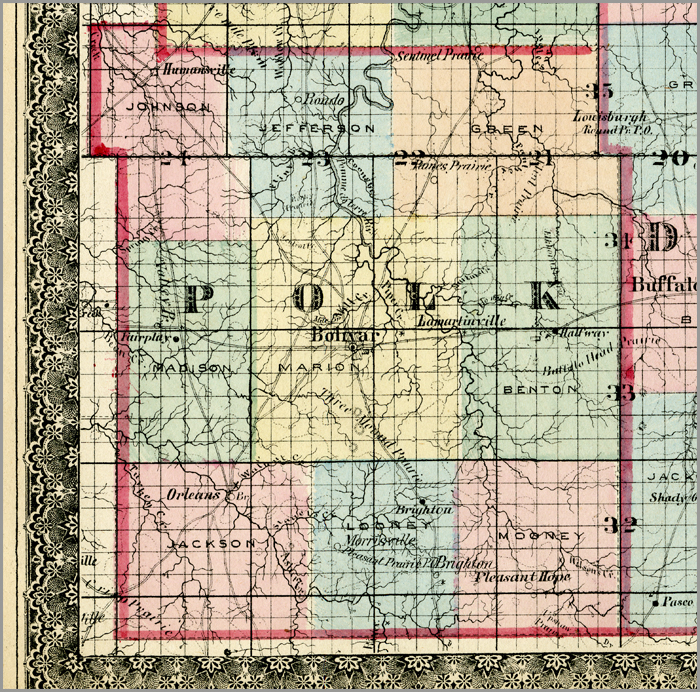Polk County, Missouri

- Formed : January 5, 1835
- County Population 1860: 10,000
- Slave Population 1860: 522
- Civil War Engagements:
-Affair at Bolivar, February 8, 1862
Image courtesy of Wilson’s Creek National Battlefield
Polk County, Missouri was originally the territory of the Osage Native American tribe until the late 1820s. James Smithson and James Mooney became the first non-Native American settlers before the Osage had officially ceded the land. Smithson and Mooney settled along Keeling Spring. However, not wishing to pay rent to the Osage, they left and settled near the James River, only to return and settle near present day Brighton in 1829. In 1830, John and Mary Jane Russell Williams became the first permanent settlers of the area, paying rent to the Osage with bacon and corn. “Bees,” an affectionate name for older citizens of surrounding areas, helped the first settlers of the Polk County area to build their homes. The main crops were oats, corn, tobacco, timothy hay, peaches, pears, and apples. The county has natural springs and rivers, including the Pomme de Terre River and Sac River, and fertile soil. All of these natural attributes made it a desired location for settlers to establish their homesteads.
On January 5, 1835, Polk County was officially formed out of Greene County and was named after Revolutionary War Colonel Ezekiel Polk. Colonel Polk was grandfather to James Polk Campbell and Ezekiel Madison Campbell, two prominent settlers of Greene and Polk Counties. Ezekiel Madison Campbell, as the first county surveyor, drew the county lines. In November of 1835, Bolivar was named the county seat after Bolivar, Tennessee, and the birthplace of Colonel Polk. They also named the town of Brighton after Brighton, Tennessee.
The increased white settlement of the area pushed most of the Osage and Kickapoo out of the area, but in 1837 they threatened to return. Residents of Polk County appealed to Missouri Governor Lilburn W. Boggs to protect them, who called in Brigadier General A.F. Nall and his troops to go and defend the county and its residents. After an 18 day conflict between the troops and the Osage, the Osage dispersed from area.
As the population continued to grow, a Presbyterian academy was established in 1849 and the area eventually became known as Pleasant Hope, after the name of the academy. In 1856, several Polk County residents left to assist relatives in Kansas, who were caught in the middle of the battle between abolitionists and pro-slavery residents of the state. Most brought their relatives back to Polk County. The 1860 census shows the population to be almost 10,000 residents, with a slave population of 512 individuals. When the Civil War began, Polk County citizens were caught in the middle: some supported President Lincoln and looked to him to defend the Union from the secessionists, some allied with Governor Claiborne Jackson, who sought to defend the state of Missouri from the Union and join the Confederacy.
Polk County residents were part of several military regiments. In June, 1861, the Polk County Regiment Home Guard formed to protect Polk County residents from both Union and Confederate armies. In December of the same year, the 8th regiment, State Militia Cavalry formed in an effort to keep communications between Springfield and Rolla open. Polk County residents were also members of the 15th regiment, U.S. Reserve Corps, who were stationed in Jefferson City to protect the railroad. The 26th Regiment, Enrolled Missouri Militia formed in July, 1862, to help control guerrilla warfare. Finally, the 15th Missouri Cavalry formed in November of 1863 to control the bushwhackers.
Several small battles and skirmishes took place in Polk County. On February 8, 1862, Union troops entered Bolivar to capture any rebel soldiers who were hiding in the city. This day became known as the “Affair at Bolivar.” On March 26, 1862, a small and brief battle took place near Humansville. Finally, on August 28, 1864, Polk County was the site of a Union attack on Confederate Captain Pace, who was killed in the skirmish.
As with many areas of the country, the Civil War had devastating effects on Polk County. Many homes were burned and destroyed; crops and livestock were stolen or killed and burned. After the war, many lawsuits were leveled against the “rebels of Polk County” who continued livestock thefts and other unlawful behavior after the war was over, in hopes of some kind of repayment for losses.
 Browse all collections in Polk County
Browse all collections in Polk County
- Consulted:
- Polk County, Missouri: History and Families, Polk County Genealogical Society, MO (New York: Turner Publishing Company, 2004).
- George F. Hooper and James C. Sterling for the Historical Society of Polk County. Polk County Classics: Sesquicentennial Photography Album (Bolivar, MO: Bolivar Free County Press, 1985).
- Polk County, MO, 1860 U.S. Federal Census – Slave Schedules [database on-line]. Provo, UT, USA: Ancestry.com Operations Inc, 2004. Original data: United States of America, Bureau of the Census. Eighth Census of the United States, 1860. Washington, D.C.: National Archives and Records Administration, 1860. M653, 1,438 rolls.












